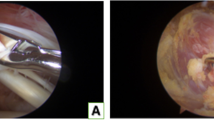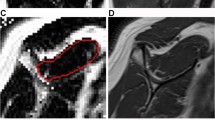Abstract
Introduction
Rotator cuff tears are common in the older population. Atrophy and fat infiltration develop un-evenly in torn supraspinatus (SSP) muscles leading to pre- and post-surgical complications. The purpose of the current study was twofold: first, to implement a volumetric and quantitative magnetic resonance imaging (MRI) approach to quantify the degree of muscle atrophy and fat infiltration within the SSP muscle and its four sub-regions (AS, PS, AD, and PD); second to compare 3-D MRI outcomes to the standard 2-D assessment and investigate their relationship with tear size.
Materials and methods
Fifteen cadaveric shoulders were obtained and MRI performed. Quantitative 3-D outcomes included SSP muscle volume, fossa volume, fat-free muscle volume, and fat fraction for the whole SSP muscle and its four sub-regions. 2-D and qualitative measurements included tear size, 2-D fat infiltration using the Goutallier classification, tangent sign, and occupation ratio.
Results
Linear regression outcomes with tear size were not significant for both cross-sectional area (r = − 0.494, p = 0.061) and occupation ratio (r = − 0.011, p = 0.969). Tear size negatively correlated with fat-free muscle volume for both AS and PS sub-regions (AS: r = − 0.78, p < 0.001; PS: r = − 0.68, p = 0.005, respectively) while showing no significant correlation with fat fraction outcomes. AD and PD sub-regions positively correlated with tear size and fat fraction outcomes (AD: r = 0.70, p = 0.017; PD: r = 0.52, p = 0.045, respectively), while no significant correlation was observed between tear size and fat-free muscle volumes.
Conclusion
Quantitative 3-D volumetric assessment of muscle degeneration resulted in better outcomes compared to the standard 2-D evaluation. The superficial supraspinatus muscle sub-regions primarily presented muscle atrophy, while the deep sub-regions were mainly affected by fat infiltration. 3-D assessments could be used pre-surgically to determine the best course of treatment and to estimate the muscles’ regenerative capacity and function.





Similar content being viewed by others
References
Chung SW, Kim JY, Kim MH, Kim SH, Oh JH (2013) Arthroscopic repair of massive rotator cuff tears: outcome and analysis of factors associated with healing failure or poor postoperative function. Am J Sports Med 41(7):1674–1683
Fabis J, Danilewicz M, Omulecka A (2001) Rabbit supraspinatus tendon detachment: effects of size and time after tenotomy on morphometric changes in the muscle. Acta Orthop Scand 72(3):282–286
Fuchs B, Weishaupt D, Zanetti M, Hodler J, Gerber C (1999) Fatty degeneration of the muscles of the rotator cuff: assessment by computed tomography versus magnetic resonance imaging. J Shoulder Elbow Surg 8(6):599–605
Fukuta S, Tsutsui T, Amari R, Wada K, Sairyo K (2016) Tendon retraction with rotator cuff tear causes a decrease in cross-sectional area of the supraspinatus muscle on magnetic resonance imaging. J Shoulder Elbow Surg 25(7):1069–1075
Gerber C, Schneeberger AG, Hoppeler H, Meyer DC (2007) Correlation of atrophy and fatty infiltration on strength and integrity of rotator cuff repairs: a study in thirteen patients. J Shoulder Elbow Surg 16(6):691–696
Giambini H, Hatta T, Krzysztof GR et al (2017) Intramuscular fat infiltration evaluated by magnetic resonance imaging predicts the extensibility of the supraspinatus muscle. Muscle Nerve 57(1):129–135
Giambini H, Hatta T, Rezaei A, An KN (2018) Extensibility of the supraspinatus muscle can be predicted by combining shear wave elastography and magnetic resonance imaging-measured quantitative metrics of stiffness and volumetric fat infiltration: a cadaveric study. Clin Biomech (Bristol, Avon) 57:144–149
Gladstone JN, Bishop JY, Lo IK, Flatow EL (2007) Fatty infiltration and atrophy of the rotator cuff do not improve after rotator cuff repair and correlate with poor functional outcome. Am J Sports Med 35(5):719–728
Goutallier D, Postel JM, Bernageau J, Lavau L, Voisin MC (1994) Fatty muscle degeneration in cuff ruptures. Pre- and postoperative evaluation by CT scan. Clin Orthop Relat Res 304:78–83
Hatta T, Giambini H, Uehara K et al (2015) Quantitative assessment of rotator cuff muscle elasticity: reliability and feasibility of shear wave elastography. J Biomech 48(14):3853–3858
Horiuchi S, Nozaki T, Tasaki A et al (2017) Reliability of MR quantification of rotator cuff muscle fatty degeneration using a 2-point Dixon technique in comparison with the Goutallier classification: validation study by multiple readers. Acad Radiol 24(11):1343–1351
Initiative USBaJ (2014) Burden of musculoskeletal diseases in the United States: prevalence, societal and economic cost(ed)^(eds), Rosemont, IL
Jo CH, Shin JS (2013) Changes in appearance of fatty infiltration and muscle atrophy of rotator cuff muscles on magnetic resonance imaging after rotator cuff repair: establishing new time-zero traits. Arthroscopy 29(3):449–458
Kikukawa K, Ide J, Kikuchi K, Morita M, Mizuta H, Ogata H (2014) Hypertrophic changes of the teres minor muscle in rotator cuff tears: quantitative evaluation by magnetic resonance imaging. J Shoulder Elbow Surg 23(12):1800–1805
Kim SY, Bleakney RR, Rindlisbacher T, Ravichandiran K, Rosser BW, Boynton E (2013) Musculotendinous architecture of pathological supraspinatus: a pilot in vivo ultrasonography study. Clin Anat 26(2):228–235
Kim SY, Boynton EL, Ravichandiran K, Fung LY, Bleakney R, Agur AM (2007) Three-dimensional study of the musculotendinous architecture of supraspinatus and its functional correlations. Clin Anat 20(6):648–655
Kim SY, Sachdeva R, Li Z, Lee D, Rosser BW (2015) Change in the pathologic supraspinatus: a three-dimensional model of fiber bundle architecture within anterior and posterior regions. Biomed Res Int 2015:564825
Lee S, Lucas RM, Lansdown DA et al (2015) Magnetic resonance rotator cuff fat fraction and its relationship with tendon tear severity and subject characteristics. J Shoulder Elbow Surg 24(9):1442–1451
Lippe J, Spang JT, Leger RR, Arciero RA, Mazzocca AD, Shea KP (2012) Inter-rater agreement of the Goutallier, Patte, and Warner classification scores using preoperative magnetic resonance imaging in patients with rotator cuff tears. Arthroscopy 28(2):154–159
Matsumura N, Oguro S, Okuda S et al (2017) Quantitative assessment of fatty infiltration and muscle volume of the rotator cuff muscles using 3-dimensional 2-point Dixon magnetic resonance imaging. J Shoulder Elbow Surg 26(10):e309–e318
Meyer DC, Hoppeler H, von Rechenberg B, Gerber C (2004) A pathomechanical concept explains muscle loss and fatty muscular changes following surgical tendon release. J Orthop Res 22(5):1004–1007
Meyer DC, Pirkl C, Pfirrmann CW, Zanetti M, Gerber C (2005) Asymmetric atrophy of the supraspinatus muscle following tendon tear. J Orthop Res 23(2):254–258
Minagawa H, Yamamoto N, Abe H et al (2013) Prevalence of symptomatic and asymptomatic rotator cuff tears in the general population: from mass-screening in one village. J Orthop 10(1):8–12
Nardo L, Karampinos DC, Lansdown DA et al (2014) Quantitative assessment of fat infiltration in the rotator cuff muscles using water-fat MRI. J Magn Reson Imaging 39(5):1178–1185
Nozaki T, Tasaki A, Horiuchi S et al (2015) Quantification of fatty degeneration within the supraspinatus muscle by using a 2-point Dixon method on 3-T MRI. AJR Am J Roentgenol 205(1):116–122
Post M, Silver R, Singh M (1983) Rotator cuff tear. Diagnosis and treatment. Clin Orthop Relat Res 173:78–91
Roh MS, Wang VM, April EW, Pollock RG, Bigliani LU, Flatow EL (2000) Anterior and posterior musculotendinous anatomy of the supraspinatus. J Shoulder Elbow Surg 9(5):436–440
Rulewicz GJ, Beaty S, Hawkins RJ, Kissenberth MJ (2013) Supraspinatus atrophy as a predictor of rotator cuff tear size: an MRI study utilizing the tangent sign. J Shoulder Elbow Surg 22(6):e6-10
Safran O, Schroeder J, Bloom R, Weil Y, Milgrom C (2011) Natural history of nonoperatively treated symptomatic rotator cuff tears in patients 60 years old or younger. Am J Sports Med 39(4):710–714
Schaefer O, Winterer J, Lohrmann C, Laubenberger J, Reichelt A, Langer M (2002) Magnetic resonance imaging for supraspinatus muscle atrophy after cuff repair. Clin Orthop Relat Res 403:93–99
Shin SJ, Chung J, Lee J, Ko YW (2016) Recovery of muscle strength after intact arthroscopic rotator cuff repair according to preoperative rotator cuff tear size. Am J Sports Med 44(4):972–980
Thomazeau H, Rolland Y, Lucas C, Duval JM, Langlais F (1996) Atrophy of the supraspinatus belly. Assessment by MRI in 55 patients with rotator cuff pathology. Acta Orthop Scand 67(3):264–268
Trevino JH 3rd, Gorny KR, Gomez-Cintron A, Zhao C, Giambini H (2019) A quantitative alternative to the Goutallier classification system using Lava Flex and Ideal MRI techniques: volumetric intramuscular fatty infiltration of the supraspinatus muscle, a cadaveric study. MAGMA 32(6):607–615
Vidt ME, Santago AC 2nd, Tuohy CJ et al (2016) Assessments of Fatty infiltration and muscle atrophy from a single magnetic resonance image slice are not predictive of 3-dimensional measurements. Arthroscopy 32(1):128–139
Williams MD, Ladermann A, Melis B, Barthelemy R, Walch G (2009) Fatty infiltration of the supraspinatus: a reliability study. J Shoulder Elbow Surg 18(4):581–587
Yamamoto A, Takagishi K, Osawa T et al (2010) Prevalence and risk factors of a rotator cuff tear in the general population. J Shoulder Elbow Surg 19(1):116–120
Yuri T, Kuwahara Y, Fujii H, Kiyoshige Y (2017) Functions of the subregions of the supraspinatus muscle. Clin Anat 30(3):347–351
Yuri T, Mura N, Yuki I, Fujii H, Kiyoshige Y (2018) Contractile property measurement of the torn supraspinatus muscle using real-time tissue elastography. J Shoulder Elbow Surg 27(9):1700–1704
Acknowledgements
This study was supported by the University of Texas at San Antonio. A co-author, Takuma Yuri, is funded by a Grant-in-Aid for JSPS fellows (Grant number 19J10699). We would like to thank Dr. Hiromi Fujii.
Author information
Authors and Affiliations
Corresponding author
Ethics declarations
Conflict of interest
The authors declare they have no conflicts of interest.
Additional information
Publisher's Note
Springer Nature remains neutral with regard to jurisdictional claims in published maps and institutional affiliations.
Rights and permissions
About this article
Cite this article
Trevino III, J.H., Yuri, T., Hatta, T. et al. Three-dimensional quantitative measurements of atrophy and fat infiltration in sub-regions of the supraspinatus muscle show heterogeneous distributions: a cadaveric study. Arch Orthop Trauma Surg 142, 1395–1403 (2022). https://doi.org/10.1007/s00402-021-03765-8
Received:
Accepted:
Published:
Issue Date:
DOI: https://doi.org/10.1007/s00402-021-03765-8




